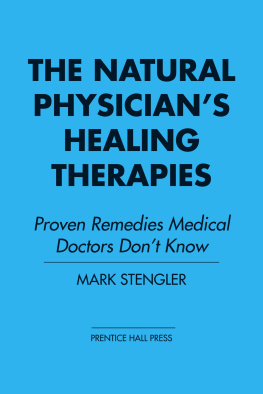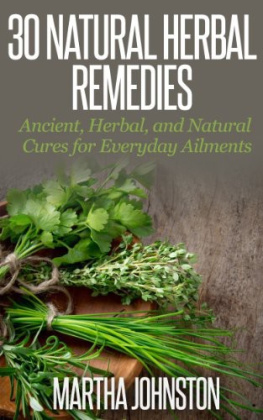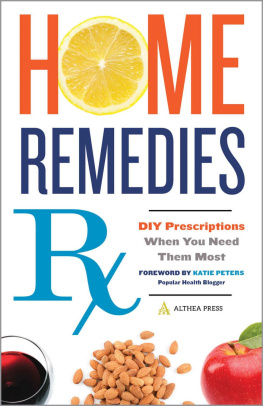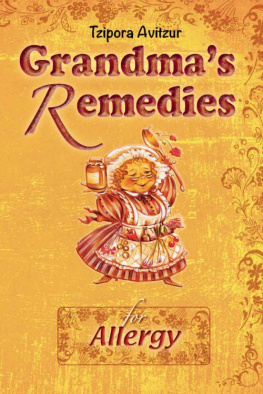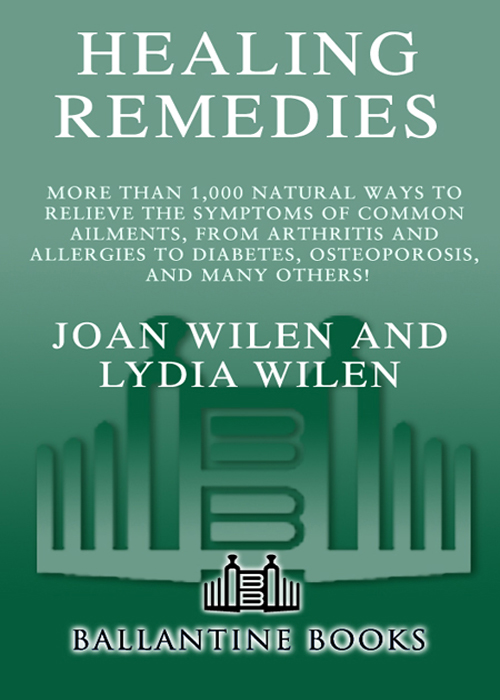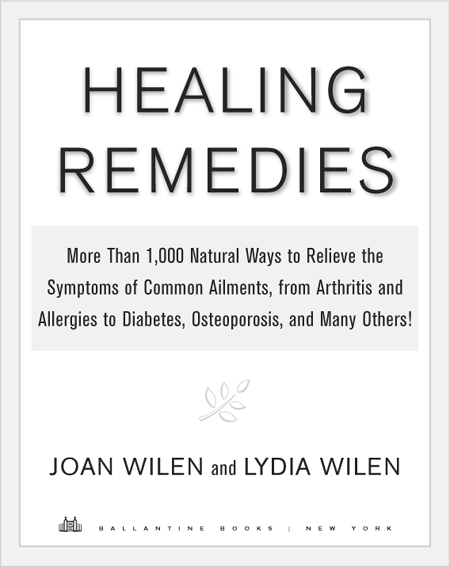our cousin and treasured friend, Linda Wilen, with whom we're happy to share the same last name.
Marty Edelston and his Boardroom, Inc., miracle makers.
Ballantine's Rachel Bernstein for planting the seed.
Jane von Mehren for green-lighting this project and putting us together with our wonderful editor.
Christina Duffy an editor we didn't dread calling to say we needed the deadline extended. Christina's enthusiasm and support were a tonic we wish we could bottle.
And to the rest of the Ballantine team for helping prepare a book that makes us proud.
W hen we started work on our very first folk remedy book decades ago, we went to all of our relatives, asking for their home remedies. We heard wonderful old-country stories about remarkable cures. But times and places have changed dramatically. Going to the outskirts of Lomza Gubernia in what is now eastern Poland to pick herbs is no longer a practical option.
This book is practical and safe and effective.
Yes, practical! Every herb, fruit, vegetable, vitamin, mineral, and liquid mentioned in the book can be bought at your local health food store, supermarket, or greengrocer, on the Internet, or by telephone. Be sure to check out our Sources section in the back of the book for worthwhile recommendations.
Our directions are easy to follow and, for the most part, specific. If exact amounts are not indicated, it means we could not find them in our reference sources, but we thought the remedy was important enough to include anyway. With regard to dosage, please use common sense and listen to your body every step of the way, taking into consideration your size and sensitivities, and your doctor's guidance.
We Wilen sisters are not medical authorities. We're researchers and writers who are not prescribing treatment; we are reporting on what has worked for people who have shared their remedies from generation to generation, up to and including the present. We are also reporting the findings of scientific research and studies in laboratories throughout the world.
To answer our concern about the information in the book being safe, we did our part by carefully reviewing all of the remedies. Now you have to do your part by consulting with your health care provider before starting any self-help health treatment. Also, for your own well-being, heed the notes, cautions, and warnings through out the book. They should make you aware that professional health care may be needed for certain ailments, especially if symptoms persist. Effective medical treatment is available for almost all conditions mentioned in this book. You can use the remedies listed here in addition to, but not as a substitute for, professional medical attention when it's really needed.
If you glance through the book, you'll see that every now and then, we have a Noteworthy insert. It's because we found wonderful items that we're excited about and want to share with you. We want you to know they exist, in case they can make you feel better (which is the goal of our book).
Due to our enthusiasm, it may seem as though we are doing a commercial for some of the products. Well, in a way we are, but that's because we recognize their potential for helping alleviate, eliminate, or prevent some health challenges. Please know that none of the companies we mention has paid us to be in the book. We have gotten product samples in order to use and evaluate each item. You will see only the ones that passed our scrutiny and lived up to our high standards.
Note to Internet holdouts: We made every effort to include telephone numbers in addition to Web site addresses. Truthfully, calling a company and asking questions is not the same as visiting a company online and seeing exactly what they have to offer. If, for whatever reason, you can't or won't get a computer and go on the Internet at home, do yourself a favor and take advantage of your local library's facilities. (Many senior centers also have computers.) A librarian may be able to help you go online. Computers and the Internet have become extremely user-friendly and fairly easy to learn. Don't feel left out. Get yourself in the loop, and have the world at your fingertips through the Internet.
Okay enough introduction. We'll let you start going through the pages.
Thank you for reading our book and for your interest in our work.
Every good wish for your good health!
Joan and Lydia
T HE W ILEN SISTERS
PREPARATION
GUIDE

T hroughout the book, we refer you to this Preparation Guide when a remedy calls for using ingredients in a way in which you probably haven't used them.
The information and simple instructions included here should take out the guesswork and replace it with answers to all of your questions with regard to processing specific ingredients.
BARLEY
Hippocrates, the father of medicine, felt that everyone should drink barley water daily to maintain good health. Barley is rich in iron and B vitamins. It is said to help prevent tooth decay and hair loss, improve fingernails and toenails, and help heal ulcers, diarrhea, and bronchial spasms. Pearl or pearled (also called Scotch) barley has been milled. During the milling process, the inedible hull and some of the bran layer are removed, which takes away some of the nutrients. Hulled barley (most often referred to as just barley), with only the outer, inedible hull removed, is more nutritious. It is also rich in dietary fiber and has more iron, more trace minerals, and four times the thiamine (vitamin B1) of pearl barley. Packages of pearl barley and (hulled) barley are sold at supermarkets; packaged and loose pearl barley and (hulled) barley are sold at most health food stores.


